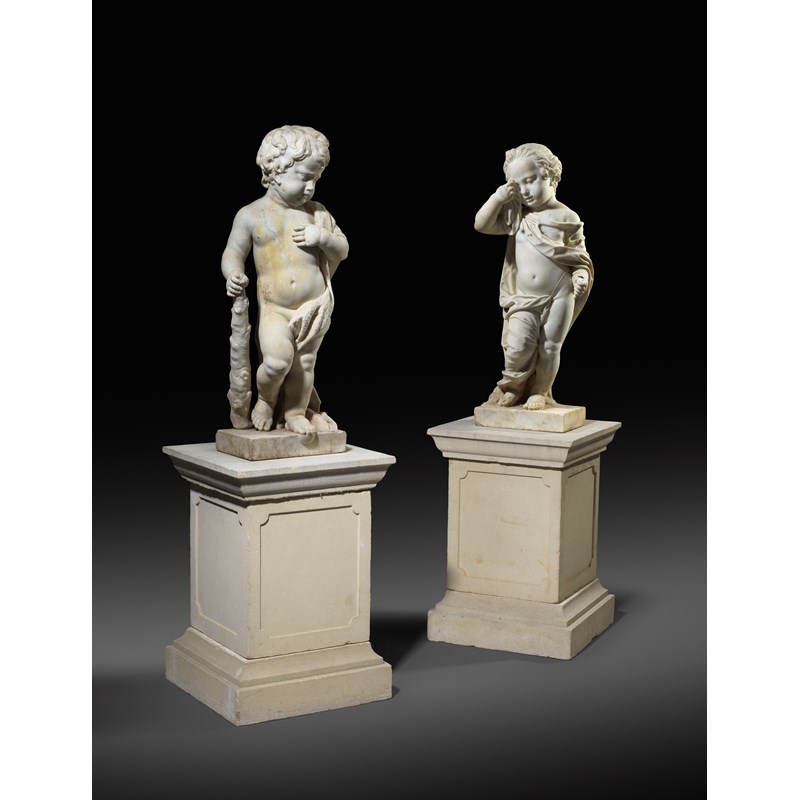Furniture, Works of Art & Clocks - 11 Aug 2020
A PAIR OF FLEMISH CARVED MARBLE ALLEGORICAL FIGURES ATTRIBUTED TO JAN CLAUDIUS DE COCK (1667-1735)
A PAIR OF FLEMISH CARVED MARBLE ALLEGORICAL FIGURES
ATTRIBUTED TO JAN CLAUDIUS DE COCK (1667-1735), LATE 17TH / EARLY 18TH CENTURY
possibly representing Day and Night, one in the form of the Infant Hercules holding a club, the other as a young girl, possibly Omphale, weeping and holding probably a torch in her left hand, now missing, on rectangular bases and later concrete plinths (4)
the figures: 91.8cm and 90.5cm high, 30.5cm wide
the plinths: 68.7cm high
PROVENANCE
Lionel de Rothschild (1882-1942)
Edmund de Rothschild (1916-2009)
The Trustees of Exbury House
COMPARATIVE LITERATURE
Leeuwenberg and W. Halsema-Kubes, Beeldhouwkunst in het Rijksmuseum, Catalogus, The Hague/Amsterdam, 1973, no. 339a ; H. Bussers, La Sculpture au Siècle de Rubens dans les Pays-Bas méridionaux et la Principauté de Liège, exh. cat., Musées Royaux des Beaux-Arts de Belgique, Brussels, 1977, p. 38, nos. 5-6; H. Bussers, « Enkele Gegevens over de Antwerpse beeldhouwer Joannes Claudius de Cock », in Bulletin des Musées Royaux des Beaux-Arts de Belgique, i-iii, 1992, pp. 331- 42; C. Lawrence, 'Cock', in J. Turner [ed.], The Dictionary of Art, London/New York, 1996, 7, pp. 500-1.
CATALOGUE NOTE
Jan Claudius de Cock was born in Antwerp and became a sculptor, draughtsman and writer. He trained during the early 1680s in the workshop of Peeter Verbrugghen the Elder, and after his death in 1686 continued to work with Peeter the Younger, joining the Guild in 1688-89 and gaining his independence in 1691. In 1693 he went to Holland to work on the Palace of Breda for King William III, Stadtholder of the Netherlands, making portrait busts of members of the House of Orange.
"By 1697-98 De Cock had returned to Antwerp, where he established a large workshop of assistants who helped produce his vast oeuvre of sacred and profane subjects on both a small and a monumental scale. As well as being influenced by the later Antwerp school of the Verbrugghen family, he admired antique art and the sculpture of François Duquesnoy (1597-1643)" (Lawrence, 1996). The famous 'putti' in all materials by the latter had become an important part of the common heritage of Flemish and Dutch sculptors thereafter.
The present statues are close in style and spirit to the secular statuary that De Cock produced for gardens, courtyards and stairwells in Dutch and Flemish houses in the 18th century, notably a marble statue of a little black boy at life-size and wearing a mural crown (a veritable crenellated fortress!), which is signed and dated 1704 (Rijksmuseum, Amsterdam, inv. R.B.K. 1972-134, 94-7 cm high: see Leeuwenberg & Halsema-Kubes 1973 and Bussers 1977). This is probably an allegory of Africa from a set of the Four Continents.
One of our figures clearly represents the Infant Hercules with the club that he was to use in his Labours, slaying a variety of horrible monsters; while the little girl perhaps held the standard symbol of Omphale, a distaff - in her lowered left hand: the piercing in her clenched fist indicates that this was perhaps fashioned in metal, for the sake of durability. In a rare moment of weakness, the hero surrendered the club, a symbol of his machismo in exchange for her ('girly') distaff, to show how much he was in love with her. The fact that she is now weeping and that both have their proper symbolic attribute returned may refer to the end of the brief love-affair.
The fact that the present pair is neither signed nor dated may be a reflection of the fact that they are not quite finished, witness the uncarved wedge of marble behind the ankles of the infant Omphale. Even so, close parallels may be found in other marble putti that are signed and dated: a pair of allegories from 1715 (a year after the Battle of Blenheim had put an end to the conquest of the Low Countries by King Louis XIV of France) representing Day - 'Dies' in Latin (wide awake, holding a torch and accompanied by a cockerel) and Night - 'Nox'(sleepy and with an owl) that was exhibited by Agnew's, London, in 1981, no. 8, 86.5 cm high. They are thought possibly to be identical with 'Two Statues Life and Death by de Cock' listed in the inventory of 1728 of the Dutch collector A. Grill, though this is at odds with the very obvious Latin inscriptions (unless those were posthumous).
Another comparable putto, this time seemingly a laurel-wreathed Cupid with a torch, setting fire to a hideous hag trying to pull him down to the ground, probably the normal allegory for Envy: bought for the Virginia Museum of Fine Arts, Richmond, VA, (58.5 x 31cm), this is dated 1731 and demonstrates Jan Claudius de Cock's versatility, vivid imagination and technical prowess.




 Live online bidding is available via our own
Live online bidding is available via our own